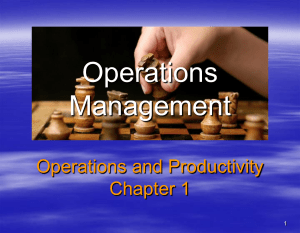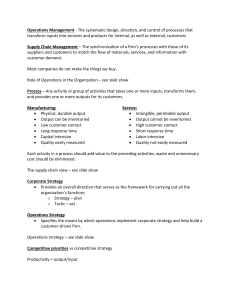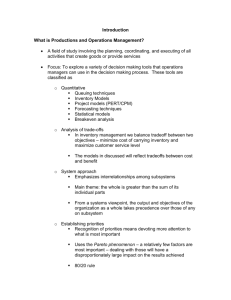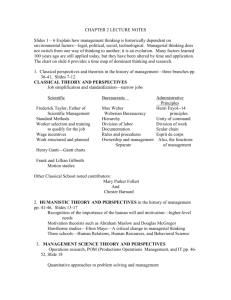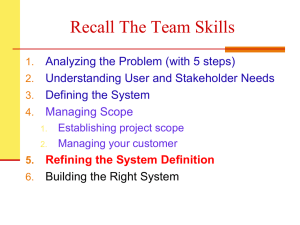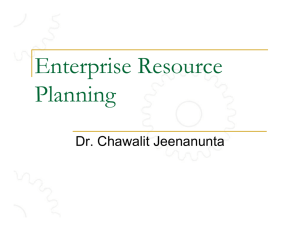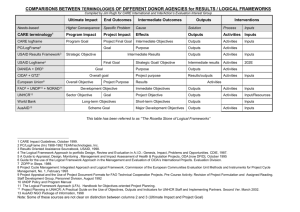Presentation
advertisement
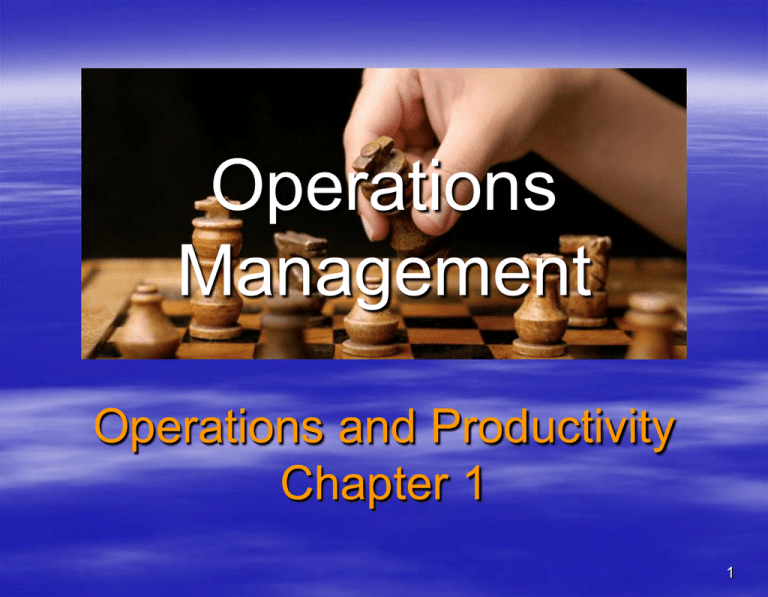
Operations Management Operations and Productivity Chapter 1 1 Outline Global company profile: Whirlpool What is Operations Management? – The heritage of Operations Management – Why study OM? – What Operations Managers do Organizing to produce goods and services Where are the OM jobs? – Exciting new Management trends in Operations Operations in the service sector The Productivity challenge 2 Learning Objectives When you complete this chapter, you should be able to: Identify or Define: – – – – Production and productivity Operations Management (OM) What operations managers do Services Describe or Explain: – A brief history of operations management – The future of the discipline – Measuring productivity 3 Whirlpool Case Example Change in attitude - employees “live quality” Training - “use your heads as well as your hands” Flexible work rules Gain-sharing Global procurement Role of information/information technology Adoption of a Worldwide strategy 4 Whirlpool’s Management Team Whirlpool Corporation’s management team believes in the company’s values-based strategy. Teamwork: From the first to the last, they take each step forward as a team. Innovation is a key strategy of Whirlpool Corporation, and an essential part of the company's long-term growth. 5 What Is Operations Management? Production is the creation of goods and services Operations management is the set of activities that creates goods and services by transforming inputs into outputs Raw materials Human inputs INPUTS Transformation process Goods Services OUTPUTS 6 Significant Events I The origins of Operations Management can be traced back to the Industrial Revolution (in the late 18th and early 19th centuries ) Division of labor (Smith, 1776) Ada Smith treats the topic of the division of labor Standardized parts (Whitney, 1800) Eli Whitney introduced concept of standard interchangeable parts in 1799 Scientific management (Taylor, 1881) He described how the application of the scientific method to the management of workers greatly could improve productivity 7 Significant Events II Coordinated assembly line (Ford 1913) Manufacturing process in which interchangeable parts are added to a product in a sequential manner to create a finished product faster than with handcrafting-type methods Gantt charts (Gantt, 1916) Gantt designed his charts so that foremen or other supervisors could quickly know whether production was on schedule, ahead of schedule or behind schedule Motion study (the Gilbreths, 1922) From their various studies the Gilbreths developed, the laws of human motion from which evolved the principles of motion economy Quality control (Shewhart, 1924) Father of statistical quality control 8 Significant Events III CPM / PERT (Dupont, 1957) CPM: Critical Path Method, is used to determine what is the shortest time to carry out the project PERT: Program (or Project) Evaluation and Review Technique, is a technique developed in the mid-50, used to program and control programmes to be carried out MRP (Orlicky, 1960) Material Requirements Planning (MRP) is a software based production planning and inventory control system used to manage manufacturing processes. CAD Flexible manufacturing systems (FMS) Manufacturing automation protocol (MAP) Computer integrated manufacturing (CIM) 9 Why Study OM? OM is one of three major functions (marketing, finance, and operations) of any organization We want (and need) to know how goods and services are produced We want to know managers do OM is such organization a what costly operations part of an 10 Why do I need OM in the future? Many graduates are expected to rise to senior management levels OM is the central core function of every company Regardless of whether your area of expertise is, the techniques and concepts of OM will help you in your business career Knowledge of OM will allow your future company to offer products and services cheaper, better, and faster. 11 What Operations Managers Do? Plan: planning the schedule according to sales demand (defining priorities) Organize: ensuring effective production of goods and services Staff: motivating and monitoring Lead: developing and cascading the organizations strategy Control: creating and maintaining a positive flow of work 12 Ten Critical Decisions Service, product design Quality management Process, capacity design Location Layout design Human resources, job design. Supply-chain management Inventory management Scheduling Maintenance 13 Organizational Functions Marketing – Gets customers. It includes advertising, distribution and selling Operations – Creates product or service – Is is the activity you carry out Finance/Accounting – Obtains funds funds for business – Tracks money 14 Where are the OM Jobs? As we said, OM is the central core function of every company, so there are a great variety of jobs in this field: Technology/methods Facilities/space utilization Strategic issues Response time People/team development Customer service Quality Cost reduction Inventory reduction Productivity improvement 15 New Challenges in OM Before Local or national focus Batch shipments Low bid purchasing After Global focus Just-in-time Supply chain partnering Lengthy product development Rapid product development, alliances Standard products Job specialization Mass customization Empowered employees, teams 16 Characteristics of Goods Tangible product Consistent product definition Production usually separate from consumption Can be inventoried thereby giving system designers additional degrees of freedom Low customer interaction 17 Characteristics of Goods 18 Characteristics of Service Intangible product. No physical form Produced & consumed at same time Often unique High customer interaction Inconsistent product definition Often knowledge-based. Labor intensive (welltrained humans) Frequently dispersed 19 Characteristics of Service Service transactions are repetitive. Service needs are continuous. The arrival rate of service request is random. Nature of service demand is heterogeneous. Customers have unique needs. Cannot be inventoried. Cannot be stored. Service quality is difficult to assess. Subjective. 20 Characteristics of Service A service is defined as a transaction in which the customer largely perceives the dominant value-adding component as being the intangible part of the product bundle. Each total product experience has a tangible component but their dominant component is intangible. 21 Examples of Services Tourist Office Officer’s advice Flying tickets 22 Goods Versus Services Goods Can be resold Can be inventoried Some aspects of quality measurable Selling is distinct from production Service Reselling unusual Difficult to inventory Quality difficult to measure Selling is part of service 23 Goods Versus Services Continued Goods Product is transportable Site of facility important for cost Service Provider, not product is transportable Site of facility important for customer contact Often easy to Often difficult to automate automate Revenue generated primarily Revenue from tangible generated primarily product from intangible 24 service. Development of the Service Economy Increasing exports + employment in services sector U.S. Employment, % Share 80 United States %70 60 Services 50 40 Canada 250 France 200 Italy 150 Industry Britain 30 20 10 U.S. Exports of Services In Billions of Dollars Services as a Percent of GDP Farming 0 1850 75 1900 25 50 75 2000 100 Japan 50 W Germany 1970 1991 40 50 60 70 Percent 0 1970 75 80 85 90 95 2000 Year 2000 data is estimated 25 The Economic System Transforms Inputs to Outputs Inputs Land, Labor, Capital, Management Process The economic system transforms inputs to outputs at about an annual 1.7% increase in productivity (capital 38% of 1.7%), labor (10% of 1.7%), management (52% of 1.7%) Outputs Goods and Services Feedback loop 26 Productivity Measure of process improvement Represents output relative to input Productivity Units produced = Input used Productivity increases improve standard of living and creates income. From 1889 to 1973, U.S. productivity increased at a 2.5% annual rate 27 Factors affecting Productivity Capital investments in production/technology/equipment/ facilities. e.g. Automatization & Computerization (minimizes tasks performed by employees). Workforce knowledge and skill Social environment. Making employees comfortable + work methods. Quality of products/processes/management Geographic factors 28 Measurement Problems Quality may change while the quantity of inputs and outputs remains constant. And will affect productivity. External elements may cause an increase or decrease in productivity Precise units of measure may be lacking. It can only be measured indirectly, that is, by measuring other variables and then calculating productivity from them. 29 Productivity Variables Labor - contributes about 10% of the annual increase. Capital - contributes about 32% of the annual increase Management - contributes about 52% of the annual increase 30 Jobs in the U.S 6% 5% Education, Health, etc. 5% Manufacturing 3% 1% 6% Retail Trade State & Local Gov't 14% Finance, Insurance 26% Wholesale Trade Transport, Public Util. 16% Construction Federal Government 18% Mining 31 Productivity Growth 1971- 1992 Labor 5 4,5 % per year 4 3,5 3 United States West Germany Japan 2,5 2 1,5 1 0,5 0 Whole Economy Manufacturing 32 Service Productivity Typically labor intensive Frequently individually processed Often an intellectual task performed by professionals Often difficult to mechanize Often difficult to evaluate for quality 33
